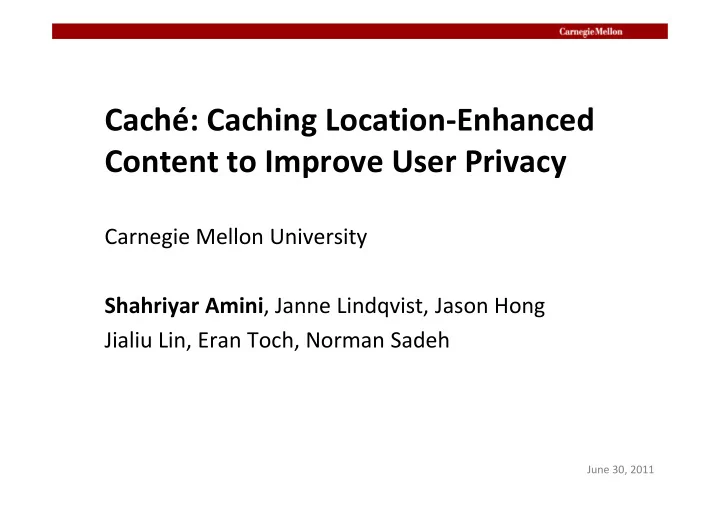

Caché: Caching Location-Enhanced Content to Improve User Privacy Carnegie Mellon University Shahriyar Amini , Janne Lindqvist, Jason Hong Jialiu Lin, Eran Toch, Norman Sadeh June 30, 2011
Widespread Adoption of Location-Enabled Devices • 2009: 150M GPS-equipped phones shipped • 2014: 770M GPS-equipped phones expected to ship (~5x increase!) • Future: Every mobile device will be location-enabled (GPS or WiFi) [Berg Insight 2010] 2
Apps Reveal Private Information • App reveals: – Time of Use – User Interest – Current Location • Over time: – Mobility Behavior – Significant Locations – Socioeconomic Status? 3
Our Approach • Pre-Fetch content for large regions • Store content on mobile device • Determine location using GPS/trusted source • Respond to queries using stored content • Periodically update content 4
Pre-Fetching Insight • Some location-based content are still useful even when old (time to live) Update Data Type Rate Real-Time Traffic flow, parking spots (STTL) e.g. Loopt, PeopleFinder, Reno, Bustle Daily weather forecasts , social events, coupons e.g. Dede Long Weekly movie/theatre schedules , advertisements, crime rates Time e.g. Yelp!, GeoNotes, PlaceIts, PlaceMail To Monthly restaurant guides, bus schedules , geocaches Live e.g. Wikipedia (geo-tagged pages) Yearly maps , points of interests, tour guides, store locators e.g. Google Maps, Starbucks, Wal-Mart 5
Feasibility of Pre-Fetching • Content doesn’t change too often – Average daily amount of change over a 5 month period • Requires <20 MB for Pittsburgh, ~100 MB for NYC 6
Pre-fetching Content • Geo-coordinates are continuous • Content cannot be pre-fetched for every point • Use a grid to discretize space 7
Caché Architecture 8
Application Design • REST-based content • Developer defines: – Size of cells – Content update rate – Query string http://api.yelp.com/v2/search?term=food&ll=#SLL_LAT#,#SLL_LON# 9
Application Installation • Regions of interest: – 15213 – Pittsburgh, PA • Pre-fetch radius – 1 km 10
Content Download • Pre-fetch only when: – Plugged in – Connected to WiFi • Pre-fetch every cell • Update content at defined update rate 11
Content Retrieval • Assume fresh content • Retrieve content from a single cell • Content miss results in a live request to LBS 12
High Content Hit Rate! • How often will queries be cached? – Locaccino: Top 20 people, 460k traces – Place naming: 26 people, 118k traces Radius (miles) Locaccino Place Naming 5 86% 79% 10 87% 84% 15 87% 86% 13
Caché Android Service • Android background service for apps – Apps modified to make requests to service – User specifies home and work locations – Service only pre-fetches when device is plugged in and connected to WiFi 14
Limitations • Doesn’t work for – Rapidly changing content (STTL) – Apps with client/server interaction (Facebook) – Apps with server computation (Navigation) • Burden falls on the developer – Developer has to effectively sweep content • New regions have to be specified before use 15
Related Work • Content Pre-fetching – Coda • Anonymity – k -anonymity, Spatial and Temporal Cloaking, Privad • Obfuscation – SybilQuery • Route prediction and caching – CacheCloak 16
Conclusion The most private and energy efficient request is the one you don’t make. • Tradeoffs: Privacy vs. Utility vs. Cost • Current solutions present challenges • Comprehensive privacy solution would rely on several approaches • Consider development and deployment 17
Recommend
More recommend